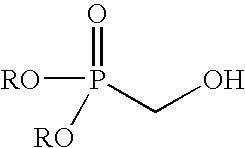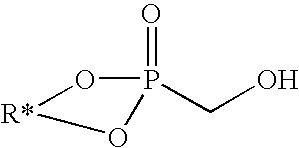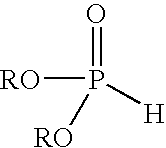Method of making hydroxymethylphosphonate, polyurethane foam-forming compositions, polyurethane foam and articles made therefrom
a technology of hydroxymethylphosphonate and polyurethane foam, which is applied in the direction of organic chemistry, organic chemistry, chemical apparatus and processes, etc., can solve the problems of low purity of various phosphonates, difficulty in reducing the acidity of phosphonates, etc., to achieve low acidity, high purity, and reduced acidity
- Summary
- Abstract
- Description
- Claims
- Application Information
AI Technical Summary
Benefits of technology
Problems solved by technology
Method used
Image
Examples
example 1
[0040]Reaction Procedure Using Diisopropylethylamine as the Hindered Amine Catalyst
[0041]The reaction heal (2.5 liters; i.e., product) was added to the 20 liter reactor vessel, followed by the addition 2480 grams of 95% reagent grade paraformaldehyde powder (78.5 moles of paraformaldehyde). After heating the reaction mixture to 50° C., 225 grams of diisopropylethylamine (303 ml, 1.74 moles) were added to the reactor, followed by the slow addition of 10350 grams of diethyl phosphite (9655 ml, 74.9 moles). The diethyl phosphite addition was completed at ˜90 grams / minute taking a little less than 2 hours. The reaction temperature was maintained at 50° C. throughout the addition. After completing the addition, the reaction temperature was raised to 75° C. and held for 1-2 hours or until all of the diethyl phosphite was consumed as indicated by P31 NMR. After a 1 hour vacuum stripping step on a rotary evaporator to remove any remaining free amine and filtration through a sintered glass f...
example 2
[0042]Reaction Procedure Using Diisopropylethylamine as the Hindered Amine Catalyst
[0043]The reaction heal (50 ml; i.e., product) was added to the 1000 ml reactor vessel, followed by the addition 49.7 grams of 95% reagent grade paraformaldehyde powder (1.58 moles of paraformaldehyde). After heating the reaction mixture to 50° C., 4.5 grams of diisopropylethylamine (6.1 ml, 0.035 moles) were added to the reactor, followed by the slow addition of 207.1 grams of diethyl phosphite (193.2 ml, 1.50 moles). The diethyl phosphite addition was completed in 1.5 hours at a rate of 2.3 grams / minute. The reaction temperature was maintained at 50° C. throughout the addition. After completing the addition, the reaction temperature was raised to 75° C. and held for 1-2 hours or until all of the diethyl phosphite was consumed as indicated by P31 NMR. After a 1 hour vacuum stripping step on a rotary evaporator to remove any remaining free amine and filtration through a sintered glass filter to remove...
example 3
[0044]Reaction Procedure Using Diisopropylethylamine as the Hindered Amine Catalyst, with Alkyl Phosphite Addition at 35° C.:
[0045]The reaction heal (50 ml; i.e., product) was added to the 1000 ml reactor vessel, followed by the addition 49.7 grams of 95% reagent grade paraformaldehyde powder (1.58 moles of paraformaldehyde). After heating the reaction mixture to 35° C., 4.5 grams of diisopropylethylamine (6.1 ml, 0.035 moles) were added to the reactor, followed by the slow addition of 207.1 grams of diethyl phosphite (193.2 ml, 1.50 moles). The diethyl phosphite addition was completed in 1.5 hours at a rate of 2.3 grams / minute. The reaction temperature was maintained at 35° C. throughout the addition. After completing the addition, the reaction temperature was raised to 75° C. and held for 1-2 hours or until all of the diethyl phosphite was consumed as indicated by P31 NMR. After a 1-hour vacuum stripping step on a rotary evaporator to remove any remaining free amine and filtration...
PUM
| Property | Measurement | Unit |
|---|---|---|
| reaction temperature | aaaaa | aaaaa |
| reaction temperature | aaaaa | aaaaa |
| reaction temperature | aaaaa | aaaaa |
Abstract
Description
Claims
Application Information
 Login to View More
Login to View More - R&D
- Intellectual Property
- Life Sciences
- Materials
- Tech Scout
- Unparalleled Data Quality
- Higher Quality Content
- 60% Fewer Hallucinations
Browse by: Latest US Patents, China's latest patents, Technical Efficacy Thesaurus, Application Domain, Technology Topic, Popular Technical Reports.
© 2025 PatSnap. All rights reserved.Legal|Privacy policy|Modern Slavery Act Transparency Statement|Sitemap|About US| Contact US: help@patsnap.com



